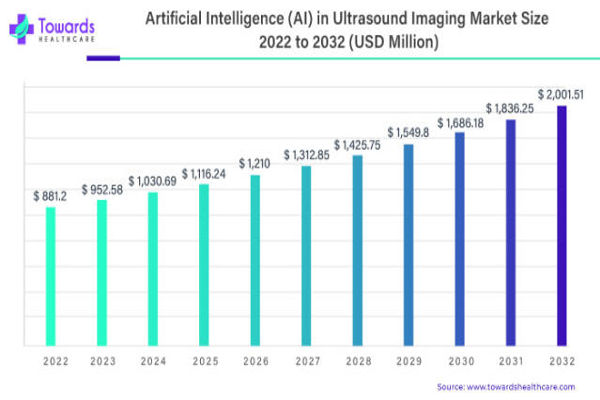The AI in ultrasound imaging market is estimated to have reached USD 881.2 million in 2022. Projections suggest that by 2032, it is poised to reach an estimated value of USD 2,001.51 million, exhibiting a robust CAGR of 8.6% between 2023 and 2032.
The integration of Artificial Intelligence (AI) in ultrasound imaging has ushered in a new era of healthcare innovation, significantly impacting surgical precision and fetal health. These transformative technologies are setting a new benchmark in healthcare innovation and are driving the demand for enhanced imaging solutions worldwide.
Ultrasound imaging, a non-invasive technique utilizing high-frequency sound waves emitted by transducers, has become a primary imaging modality in clinical settings. While most diagnostic probes are placed on the skin, they can also be inserted internally through the gastrointestinal tract, vagina, or blood vessels for better image quality. In surgical settings, sterile probes are utilized. The potential of AI in ultrasound imaging to elevate medical diagnostics is vast, with applications ranging from assisting physicians in diagnosis and triage to improving overall patient care.
AI-based ultrasound imaging systems consist of several components, including compensating amplifiers, transducers, transmitter pulse generators, digital processors, control units for focusing, and display systems. The global market for AI in imaging has witnessed significant growth, with AI technologies increasingly integrated into ultrasound systems to enhance image quality, diagnostic accuracy, and workflow efficiency. These advancements aim to assist healthcare professionals in interpreting ultrasound scans, detecting abnormalities, and improving patient care.
For example, AI algorithms aid in image reconstruction in both 3D and 2D ultrasound, enhancing anatomy visibility and enabling more precise diagnoses. These developments help detect anomalies and improve visualization, contributing to the surge in the global ultrasound imaging market.
Rising Global Disease Rate Increases Demand for AI in Ultrasound Imaging Market
The rising global disease rate, particularly cardiovascular diseases and digestive disorders, has increased the demand for AI in ultrasound imaging. Heart attacks and strokes alone account for 85% of worldwide deaths, with cardiovascular diseases causing 17.9 million deaths annually. Similarly, digestive disorders contribute to significant mortality rates. The prevalence of these diseases necessitates faster and more accurate diagnostic procedures, leading to an increasing need for advanced AI-enhanced ultrasound imaging in hospitals and clinics worldwide.
AI-ultrasound imaging is crucial for early detection, facilitating faster and more efficient diagnoses. Its demand is growing to meet the escalating requirements for improved medical imaging solutions. AI in ultrasound imaging acts as an intelligent helper for doctors, enabling faster problem detection, especially in cardiovascular diseases, digestive disorders, and obstetrics/gynecology. Early detection through AI-enhanced ultrasound imaging allows for timely and effective medical interventions, emphasizing the importance of treating issues sooner to deal with global disease prevalence. AI applications in ultrasound have revolutionized medical imaging by providing navigation and automated quantification tools for various areas such as breast, prostate, liver, heart, and obstetrics/gynecology. In obstetrics, AI aids in workload management by automatically detecting standard planes and ensures quality assurance in fetal ultrasound. It also assists in gynecological assessments by detecting endometrial thickness and classifying ovarian cysts. AI enhances diagnostic capabilities in cardiac evaluations, vessel characterization, liver imaging, and pathology detection, driving the growth of the global AI ultrasound imaging market.
Artificial intelligence (AI) has become a transformative force in various sectors, particularly in healthcare. In the medical field, AI has facilitated the development of new medications, supported clinical judgments, and enhanced the quality of ultrasound imaging. Applications of AI in ultrasound imaging have gained approval from regulatory bodies like the European Union and the US Food and Drug Administration (FDA), signifying a significant milestone. The integration of AI into ultrasound imaging has rapidly expanded, addressing diverse clinical needs, including prioritizing critical imaging studies for radiologists.
Interdisciplinary collaboration between AI developers and ultrasound specialists is crucial, especially in fields like Obstetrics and Gynecology, where ultrasound imaging is frequently employed.
For example:
In a recent review by the National Health Institute in 2020, it was emphasized that more collaboration between computer science scientists and healthcare providers is needed to produce impactful work integrating knowledge from both fields. The exponential growth of electronic data worldwide has accelerated the development of AI in medical imaging. Over fifty deep learning-based imaging applications, including those for ultrasound, have gained FDA or EU approval. These applications enhance productivity through automated screening, diagnosis support, and study prioritization. In 2023, the FDA approved the first ultrasound AI application to provide guidance during adult echocardiography, improving image quality. The market for AI in medical imaging is projected to exceed $2 billion. However, ethical concerns pose challenges to the widespread adoption of AI in healthcare. Patient privacy and data security are paramount, with risks of unauthorized access and data breaches. Achieving informed consent from patients becomes complex as AI systems evolve, requiring transparent communication about data usage.
Moreover, the “black box” nature of AI algorithms raises interpretability and accountability issues, hindering user trust and adoption rates. Regulatory agencies and healthcare organizations are cautious, analyzing the ethical implications of AI solutions.
Ultrasound technology plays a pivotal role in driving AI’s growth in the imaging market. AI algorithms enhance image analysis, automate measurements, and improve diagnostic accuracy. Recent advancements include 2D phased array transducers with 3D beam sweeping capabilities, enabling real-time 3D imaging.
Furthermore, AI aids in kidney stone detection, treatment planning, and monitoring through extracorporeal shockwave lithotripsy (ESWL). Doppler ultrasound, evaluating blood flow, enhances cardiovascular studies, aiding in diagnosing vascular conditions. North America dominates the AI ultrasound imaging market due to advanced healthcare facilities and research investments. Asia Pacific, with its inexpensive production factors, is a prominent manufacturer of ultrasound imaging devices, driving market growth.
In the competitive landscape:
Organizations strive to adopt AI solutions for precise diagnostics and enhanced patient care, fostering innovation and competition. See-Mode Technologies Pte. Ltd. received FDA clearance for its novel Vascular Ultrasound Scanner in September 2020, employing machine learning for vessel wall segmentation. Philips Healthcare gained FDA approval in March 2020 for its Ultrasound solutions for treating lung and cardiac complications associated with COVID-19.













